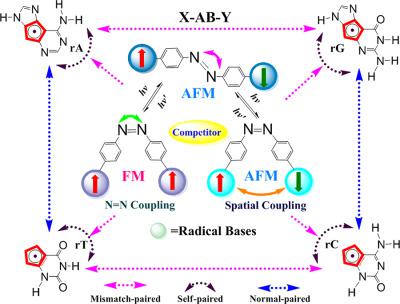当前位置:
X-MOL 学术
›
J. Comput. Chem.
›
论文详情
Our official English website, www.x-mol.net, welcomes your feedback! (Note: you will need to create a separate account there.)
Azobenzene-bridged diradical janus nucleobases with photo-converted magnetic properties between antiferromagnetic and ferromagnetic couplings
Journal of Computational Chemistry ( IF 3 ) Pub Date : 2018-03-05 , DOI: 10.1002/jcc.25207 Peiwen Zhao 1 , Yuxiang Bu 1, 2
Journal of Computational Chemistry ( IF 3 ) Pub Date : 2018-03-05 , DOI: 10.1002/jcc.25207 Peiwen Zhao 1 , Yuxiang Bu 1, 2
Affiliation

|
We computationally design a series of azobenzene (AB)‐bridged double radicalized nucleobases, a novel kind of diradical Janus‐type nucleobases, and explore their spin coupling characteristics. Calculations prove that such diradical Janus‐bases not only normally match with their complementary bases, but also exhibit well‐defined diradical character with photo‐convertible intramolecular magnetic couplings (antiferromagnetic vs. ferromagnetic). Combination of four radical nucleobases (rG, rA, rC, rT) and photoswitch AB can yield 10 diradical Janus‐bases with different magnetic characteristics in which AB functions a bridge to mediate the spin coupling between two radical bases. The trans‐form supports mild antiferromagnetic couplings with the spin coupling constants (J) ranging from −153.6 cm−1 to −50.91 cm−1 while the cis‐form has weak magnetic couplings with ferromagnetic (0.22–8.50 cm−1) for most of them or antiferromagnetic (−0.77, −1.73, −3.30 cm−1) properties for only three. Further structural examination and frontier molecular orbital analyses indicate that the extended π conjugation for better spin polarization provides an effective through‐π‐bond pathway to mediate the spin coupling in the trans conformation while nonplanarity of the cis conformation weakens the through‐bond coupling and causes a competitive through‐space pathway and as an overall result inhibits the spin coupling between two spin moieties. Meanwhile, we also find that the J values of the cis conformation vary with their angle between the radical base and its linked phenylene. Furthermore, the magnetic properties of the diradical Janus‐bases can be significantly increased by interacting with metal ions. They also maintain a good UV absorption characteristics and there is a clear redshift compared with AB. This work provides a promising strategy for the rational design of photo‐convertible Janus‐base magnets as the magnetism‐tunable DNA building blocks. © 2018 Wiley Periodicals, Inc.
中文翻译:

在反铁磁和铁磁耦合之间具有光转换磁特性的偶氮苯桥连双自由基 janus 核碱基
我们通过计算设计了一系列偶氮苯 (AB) 桥连双自由基核碱基,一种新型的双自由基 Janus 型核碱基,并探索了它们的自旋耦合特性。计算证明,这种双自由基 Janus 碱基不仅通常与其互补碱基匹配,而且还表现出明确的双自由基特性,具有光可转换的分子内磁耦合(反铁磁与铁磁)。四个自由基核碱基(rG、rA、rC、rT)和光开关 AB 的组合可以产生 10 个具有不同磁特性的双自由基 Janus 碱基,其中 AB 起到桥梁的作用来介导两个自由基碱基之间的自旋耦合。变换形式支持温和的反铁磁耦合,自旋耦合常数 (J) 范围从 -153.6 cm-1 到 -50。91 cm-1,而顺式具有弱磁耦合,其中大多数具有铁磁(0.22-8.50 cm-1)或仅三个具有反铁磁(-0.77、-1.73、-3.30 cm-1)特性。进一步的结构检查和前沿分子轨道分析表明,为了更好的自旋极化而扩展的 π 共轭提供了有效的通过 π 键途径来介导反式构象中的自旋耦合,而顺式构象的非平面性削弱了通过键耦合并导致一种竞争性的空间通路,作为整体结果,抑制了两个自旋部分之间的自旋耦合。同时,我们还发现顺式构象的 J 值随自由基碱基与其连接的亚苯基之间的角度而变化。此外,通过与金属离子相互作用可以显着提高双自由基 Janus 碱的磁性。它们还保持良好的紫外线吸收特性,与 AB 相比有明显的红移。这项工作为合理设计光可转换 Janus 基磁铁作为磁性可调 DNA 构建块提供了一种有前景的策略。© 2018 Wiley Periodicals, Inc.
更新日期:2018-03-05
中文翻译:

在反铁磁和铁磁耦合之间具有光转换磁特性的偶氮苯桥连双自由基 janus 核碱基
我们通过计算设计了一系列偶氮苯 (AB) 桥连双自由基核碱基,一种新型的双自由基 Janus 型核碱基,并探索了它们的自旋耦合特性。计算证明,这种双自由基 Janus 碱基不仅通常与其互补碱基匹配,而且还表现出明确的双自由基特性,具有光可转换的分子内磁耦合(反铁磁与铁磁)。四个自由基核碱基(rG、rA、rC、rT)和光开关 AB 的组合可以产生 10 个具有不同磁特性的双自由基 Janus 碱基,其中 AB 起到桥梁的作用来介导两个自由基碱基之间的自旋耦合。变换形式支持温和的反铁磁耦合,自旋耦合常数 (J) 范围从 -153.6 cm-1 到 -50。91 cm-1,而顺式具有弱磁耦合,其中大多数具有铁磁(0.22-8.50 cm-1)或仅三个具有反铁磁(-0.77、-1.73、-3.30 cm-1)特性。进一步的结构检查和前沿分子轨道分析表明,为了更好的自旋极化而扩展的 π 共轭提供了有效的通过 π 键途径来介导反式构象中的自旋耦合,而顺式构象的非平面性削弱了通过键耦合并导致一种竞争性的空间通路,作为整体结果,抑制了两个自旋部分之间的自旋耦合。同时,我们还发现顺式构象的 J 值随自由基碱基与其连接的亚苯基之间的角度而变化。此外,通过与金属离子相互作用可以显着提高双自由基 Janus 碱的磁性。它们还保持良好的紫外线吸收特性,与 AB 相比有明显的红移。这项工作为合理设计光可转换 Janus 基磁铁作为磁性可调 DNA 构建块提供了一种有前景的策略。© 2018 Wiley Periodicals, Inc.



























 京公网安备 11010802027423号
京公网安备 11010802027423号